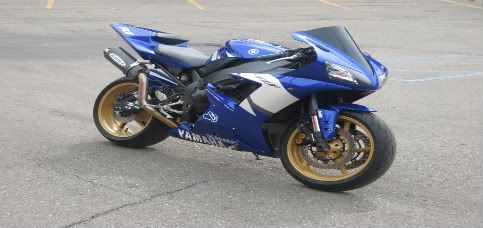A 520 conversion simply mean converting your current chain, which on the FZR600 is a 530, to a lighter weight chain/sprockets. On a 600cc bike, this is really no issue, but larger 1000cc bikes should go with a 530 or better chain due to their greater torque. The different chain sizes refer to the pitch and inner width (roller) dimensions. When you reduce the weight of the chain or the width, you are also reducing the thickness of the sprockets and thereby also reducing their weight.
Here is a quick reference for Chain size dimensions -
Chain Size :: Pitch :: Inner Width (roller)
520 :: 5/8" :: 1/4"
525 :: 5/8" :: 5/16"
530 :: 5/8" :: 3/8"
Along with the lighter chain many choose to also change their gearing by changing the sprocket tooth count on both the front and rear sprockets since the new chain requires sprockets designed to work with the smaller chain size. Sprockets will be labeled with the chain size (520, 525, 530, ...)
A stock FZR600 comes with a 15/45 or 15 teeth on the front sprocket and 45 on the rear sprocket. This comes to be a 3.00 ratio, which gives the FZR600 a top speed of roughly 144.70 mph.
The most common change on the FZR600 is a 14/47 which gives you a 3.36 ratio. This allows a quicker take-off, but a reduced top-speed of roughly 129 mph. See the graph below for other sizes and top speeds.
Several companies offer kits that will save you money, but be cautious, not all companies supply you with the same quality chain. Here is a link with descriptions of the various chains, manufactured by RK, a leader in high quality chains.(http://www.rkexcelamerica.com/street_rk_chain.html)
In these 520 conversion kits, you will usually get a steel alloy front sprocket and an aluminum rear sprocket. Some say the aluminum sprockets last 3000 miles or more, while others will tell you that they wear out quickly. I can only imagine that maintenance, proper installation and style of riding varies greatly among those who have commented.
The biggest issues surrounding wear are: insufficient chain lubrication, improper chain tension and misalignment between the sprockets.
A note about front sprocket changes: Reducing the front sprocket tooth count by one roughly equals a reduction of 2-3 teeth on the rear sprocket. However; reducing the front sprocket also bends the chain further which may prematurely wear the chain out. So, go with a larger rear sprocket like a 49 tooth. While this may seem large, it is a common size and you can run a 14, 15 or even 16 tooth front sprocket for different applications. Keep all 3 sizes in your tool box. Use the 14 for a Track Day on a short, tight course, a 15 for a Track Day with longer straights and the 16 for street use for better gas mileage. Plus, replacing the front sprocket is much easier than replacing the rear.






